


The Amazing Game of Chess
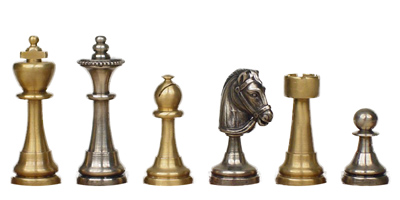
Before I begin let me say that I really know nothing about Chess. It is all new to me, however, I do think it is interesting and I want to investigate it. This definitely is not the definitive definition of Chess.
The history of chess can be traced back nearly 1500 years, although the earliest origins are uncertain. The earliest predecessor of the game probably originated in India, before the 6th century AD. From India, the game spread to Persia. When the Arabs conquered Persia, chess was taken up by the Muslim world and subsequently spread to Southern Europe. In Europe, chess evolved into roughly its current form in the 15th century.
Chess was probably introduced to China by Buddhists who traveled from India to further their religion or escape persecution. In Chinese chess, the pieces are placed on the intersections of the lines rather than on the squares and a celestial river, akin to no man's land, was added between halves on the 9 x10 board.
"Romantic chess" was the predominant chess playing style from the late 15th century to the 1880s. Chess games of this period emphasized more on quick, tactical maneuvers rather than long-term strategic planning.
The Queen
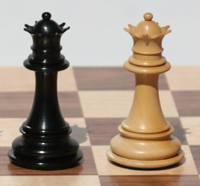 The Queen is the most powerful piece in the game of chess, able to move any number of squares vertically, horizontally or diagonally. Each player starts the game with one queen, placed in the middle of the first rank next to the king. Because the queen is the strongest piece, a pawn is promoted to a queen in the vast majority of cases. In the game Shatranj, the ancestor of chess that included only male figures, the closest thing to the queen was the ferz, a weak piece only able to move or capture one step diagonally and not at all in any other direction. The modern chess queen gained power in the 15th century.
The Queen is the most powerful piece in the game of chess, able to move any number of squares vertically, horizontally or diagonally. Each player starts the game with one queen, placed in the middle of the first rank next to the king. Because the queen is the strongest piece, a pawn is promoted to a queen in the vast majority of cases. In the game Shatranj, the ancestor of chess that included only male figures, the closest thing to the queen was the ferz, a weak piece only able to move or capture one step diagonally and not at all in any other direction. The modern chess queen gained power in the 15th century.
The white queen starts on d1, while the black queen starts on d8. With the chessboard oriented correctly, the white queen starts on a white square and the black queen starts on a black square—thus the mnemonics "queen gets her color", "queen on [her] [own] color", or "the dress [queen piece] matches the shoes [square]."
Although both players start with one queen each, a pawn can be promoted to any of several types of pieces, including a queen, when the pawn is moved to the player's furthest rank (the opponent's first rank). Such a queen created by promotion can be an additional queen, or if the player's queen has been captured, a replacement queen. Pawn promotion to a queen is colloquially called queening, which is by far the most common type of piece a pawn is promoted to due to the relative power of a queen.
Ordinarily, the queen is slightly stronger than a rook and a bishop together, while slightly less strong than two rooks. It is almost always disadvantageous to exchange the queen for a single piece other than the enemy's queen.
The reason that the queen is stronger than a combination of a rook and bishop, even though they control the same number of squares, is twofold. First, the queen is more mobile than the rook and the bishop, as the entire power of the queen can be transferred to another location in one move, while transferring the entire firepower of a rook and bishop requires two moves, the bishop always being restricted to squares of one color. Second, the queen is not hampered by the bishop's inability to control squares of the opposite color to the square on which it stands. A factor in favor of the rook and bishop is that they can attack (or defend) a square twice, while a queen can only do so once. However, experience has shown that this factor is usually less significant than the points favoring the queen.
The queen is strongest when the board is open, when the enemy king is poorly defended, or when there are loose (i.e. undefended) pieces in the enemy camp. Because of her long range and ability to move in multiple directions, the queen is well equipped to execute forks. Compared to other long range pieces (i.e. rooks and bishops), the queen is less restricted and stronger in closed positions.
Beginners often develop the queen early in the game, hoping to plunder the enemy position and deliver an early checkmate such as Scholar's mate. This can expose the easily harassed queen to attacks by weaker pieces causing the player to lose time. Experienced players generally prefer to delay developing the queen, and instead develop minor pieces in the opening.
Early queen attacks are rare in high level chess, but there are some openings with early queen development that are used by high level players. For example, the Scandinavian Defense (1.e4 d5), which often features queen moves by Black on the second and third moves is considered sound, and has been played at the world championship level. Some less common examples have also been observed in high-level games. The Danvers Opening (1.e4 e5 2.Qh5), which is widely characterized as a beginner's opening, has occasionally been played by the strong American grandmaster Hikaru Nakamura.
A queen exchange often marks the beginning of the endgame, but there are queen endgames, and sometimes queens are exchanged in the opening, long before the endgame. A common goal in the endgame is to promote a pawn to a queen. As the queen has the largest range and mobility, queen and king vs. lone king is an easy win when compared to some other basic mates.
A queen sacrifice is the deliberate sacrifice of a queen in order to gain a more favorable tactical position.
The King
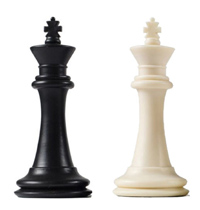 The King is the most important piece in the game of chess. The object of the game is to threaten the opponent's king in such a way that escape is not possible (checkmate). If a player's king is threatened with capture, it is said to be in check, and the player must remove the threat of capture on the next move. If this cannot be done, the king is said to be in checkmate, resulting in a loss for that player. Although the king is the most important piece, it is usually the weakest piece in the game until a later phase, the endgame. Players cannot make any move that places their own king in check.
The King is the most important piece in the game of chess. The object of the game is to threaten the opponent's king in such a way that escape is not possible (checkmate). If a player's king is threatened with capture, it is said to be in check, and the player must remove the threat of capture on the next move. If this cannot be done, the king is said to be in checkmate, resulting in a loss for that player. Although the king is the most important piece, it is usually the weakest piece in the game until a later phase, the endgame. Players cannot make any move that places their own king in check.
White starts with the king on the first rank to the right of the queen. Black starts with the king directly across from the white king. The white king starts on e1 and the black king on e8.
A king can move one square in any direction (horizontally, vertically, or diagonally) unless the square is already occupied by a friendly piece or the move would place the king in check. As a result, opposing kings may never occupy adjacent squares (see opposition), but the king can give discovered check by unmasking a bishop, rook, or queen. The king is also involved in the special move of castling.
Castling: In conjunction with a rook, the king may make a special move called castling, in which the king moves two squares toward one of its rooks and then the rook is placed on the square over which the king crossed. Castling is allowed only when neither the king nor the castling rook previously moved, no squares between them are occupied, the king is not in check, and the king will not move across or end its movement on a square that is under enemy attack.
A king that is under attack is said to be in check, and the player in check must immediately remedy the situation. There are three possible ways to remove the king from check:
- The king is moved to an adjacent non-threatened square. A king cannot castle to get out of check.
- A piece is interposed between the king and the attacking piece to break the line of threat (not possible when the attacking piece is a knight or pawn, or when in double check).
- The attacking piece is captured (not possible when in double check, unless the king captures).
A stalemate occurs when a player, on their turn, has no legal moves, and the player's king is not in check. If this happens, the king is said to have been stalemated and the game ends in a draw. A player who has very little or no chance of winning will often, in order to avoid a loss, try to entice the opponent to inadvertently place the player's king in stalemate.
In the opening and middlegame, the king will rarely play an active role in the development of an offensive or defensive position. Instead, a player will normally try to castle and seek safety on the edge of the board behind friendly pawns. In the endgame, however, the king emerges to play an active role as an offensive piece as well as assisting in the promotion of their remaining pawns.
The Rook
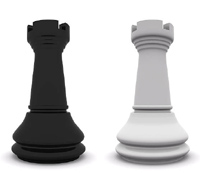 The Rook is a piece in the game of chess. Formerly the piece, from Persian, was called the tower, marquess, rector, and comes. The term castle is considered informal, incorrect, or old-fashioned. Each player starts the game with two rooks, one on each of the corner squares on their own side of the board.
The Rook is a piece in the game of chess. Formerly the piece, from Persian, was called the tower, marquess, rector, and comes. The term castle is considered informal, incorrect, or old-fashioned. Each player starts the game with two rooks, one on each of the corner squares on their own side of the board.
The white rooks start on squares a1 and h1, while the black rooks start on a8 and h8. The rook moves horizontally or vertically, through any number of unoccupied squares. As with captures by other pieces, the rook captures by occupying the square on which the enemy piece sits. The rook also participates, with the king, in a special move called castling.
In general, rooks are stronger than bishops or knights (which are called minor pieces) and are considered greater in value than either of those pieces by nearly two pawns but less valuable than two minor pieces by approximately a pawn. Two rooks are generally considered to be worth slightly more than a queen (see chess piece relative value). Winning a rook for a bishop or knight is referred to as winning the exchange. Rooks and queens are called heavy pieces or major pieces, as opposed to bishops and knights, the minor pieces.
In the opening, the rooks are blocked in by other pieces and cannot immediately participate in the game, so it is usually desirable to connect one's rooks on the first rank by clearing all pieces except the king and rooks from the first rank and then castling. In that position, the rooks support each other, and can more easily move to occupy and control the most favorable files.
A common strategic goal is to develop a rook on the first rank of an open file (i.e. one unobstructed by pawns of either player), or a half-open file (i.e., one unobstructed by friendly pawns). From this position, the rook is relatively unexposed to risk but can exert control on every square on the file. If one file is particularly important, a player might advance one rook on it, then position the other rook behind – doubling the rooks.
A rook on the seventh rank (the opponent's second rank) is typically very powerful, as it threatens the opponent's unadvanced pawns and hems in the enemy king. A rook on the seventh rank is often considered sufficient compensation for a pawn.
Two rooks on the seventh rank are often enough to force victory, or at least a draw by perpetual check.
Rooks are most powerful towards the end of a game (i.e., the endgame), when they can move unobstructed by pawns and control large numbers of squares. They are somewhat clumsy at restraining enemy pawns from advancing towards promotion, unless they can occupy the file behind the advancing pawn. As well, a rook best supports a friendly pawn towards promotion from behind it on the same file.
In a position with a rook and one or two minor pieces versus two rooks, generally in addition to pawns, and possibly other pieces – Lev Alburt advises that the player with the single rook should avoid exchanging the rook for one of his opponent's rooks.
The Knight
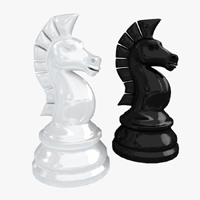 The Knight is a piece in the game of chess, representing a knight (armored cavalry). It is normally represented by a horse's head and neck. Each player starts with two knights, which begin on the row closest to the player, between the rooks and bishops.
The Knight is a piece in the game of chess, representing a knight (armored cavalry). It is normally represented by a horse's head and neck. Each player starts with two knights, which begin on the row closest to the player, between the rooks and bishops.
Colloquially it is sometimes referred to as a "horse", which is also the translation of the piece's name in several languages. Some languages refer to it as the "jumper", reflecting the knight's ability to move over pieces in its way: Polish skoczek, Danish/Norwegian springer, German Springer, Luxembourgish Sprénger, Slovene skakač. In Sicilian it is called sceccu, a slang term for a donkey, derived from the Arabic sheikh, who during the Islamic period rode from village to village on donkeys collecting taxes.
The knight move is unusual among chess pieces. It moves to a square that is two squares away horizontally and one square vertically, or two squares vertically and one square horizontally. The complete move therefore looks like the letter "L". Unlike all other standard chess pieces, the knight can "jump over" all other pieces (of either color) to its destination square. It captures an enemy piece by replacing it on its square. The knight's ability to "jump over" other pieces means it tends to be at its most powerful in closed positions, in contrast to a bishop. The knight moves alternately to light and dark squares.
A knight should always be close to where the action is, meaning it is best used on areas of the board where the opponent's pieces are clustered or close together. Pieces are generally more powerful if placed near the center of the board, but this is particularly true for a knight. A knight on the edge of the board attacks only three or four squares (depending on its exact location) and a knight in the corner only two. Moreover, it takes more moves for an uncentralized knight to switch operation to the opposite side of the board than an uncentralized bishop, rook, or queen. The mnemonic phrases "A knight on the rim is grim" or "A knight on the rim is dim" are often used in chess instruction to reflect this principle.
The knight is the only piece that can move at the beginning of the game without first moving a pawn. For the reasons above, the best square for the initial move of each knight is usually one towards the center. Knights are usually brought into play slightly sooner than the bishops and much sooner than the rooks and the queen.
A knight is approximately equal in strength and value to a bishop. The bishop has longer range, but is restricted to only half the squares on the board. Since the knight can jump over pieces which obstruct other pieces, it is usually more valuable when the board is more crowded (closed positions, and early in the game). A knight is best when it has a "support point" or outpost – a relatively sheltered square where it can be positioned to exert its strength remotely. On the fourth rank a knight is comparable in power to a bishop, and on the fifth it is often superior to the bishop, and on the sixth rank it can be a decisive advantage. This is assuming the knight is taking part in the action; a knight on the sixth rank which is not doing anything useful is not a well-placed piece. A knight is usually worst positioned on the edge of the board.
Enemy pawns are very effective at harassing knights because a pawn attacking a knight is not itself attacked by the knight. For this reason, a knight is most effective when placed in a weakness in the opponent's pawn structure, i.e. a square which cannot be attacked by enemy pawns.
Whereas two bishops cover each other's weaknesses, two knights tend not to cooperate with each other as efficiently. As such, a pair of bishops is usually considered better than a pair of knights. World Champion José Raúl Capablanca considered that a queen and a knight is usually a better combination than a queen and a bishop. However, Glenn Flear found no game of Capablanca's that supported his statement and statistics do not support the statement either. In an endgame without other pieces or pawns, two knights generally have a better chance against a queen than two bishops or a bishop and a knight.
Compared to a bishop, a knight is often not as good in an endgame. The knight's potential range of movement is more limited, which often makes it less suitable in endgames with pawns on both sides of the board. However, this limitation is less important in endgames with pawns on only one side of the board. Knights are superior to bishops in an endgame if all the pawns are on one side of the board. Furthermore, knights have the advantage of being able to control squares of either color, unlike a lone bishop. Nonetheless, a disadvantage of the knight (compared to the other pieces) is that by itself it cannot lose a move to put the opponent in zugzwang (see triangulation and tempo), while a bishop can. In this position, if the knight is on a white square and it is White's turn to move, White cannot win. Similarly, if the knight was on a black square and it was Black's turn to move, White cannot win. In the other two cases, White would win. If instead of the knight, White had a bishop on either color of square, White would win with either side to move.
At the end of the game, if one side has only a king and a knight while the other side has only a king, the game is a draw since a checkmate is impossible. When a bare king faces a king and two knights, checkmate can occur only if the opponent commits a blunder by moving his king to a square where it may be checkmated on the next move. Otherwise, a checkmate can never be forced. However checkmate can be forced with a bishop and knight, or with two bishops, even though the bishop and knight are in general about equal in value. Paradoxically, checkmate with two knights sometimes can be forced if the weaker side has a single extra pawn, but this is a curiosity of little practical value (see two knights endgame). Pawnless endings are a rarity, and if the stronger side has even a single pawn, an extra knight should give him an easy win. A bishop can trap (although it cannot then capture) a knight on the rim, especially in the endgame.
The Bishop
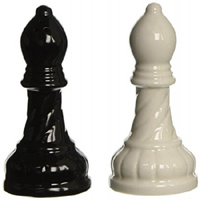 The Bishop is a piece in the game of chess. Each player begins the game with two bishops. One starts between the king's knight and the king, the other between the queen's knight and the queen. The starting squares are c1 and f1 for White's bishops, and c8 and f8 for Black's bishops.
The Bishop is a piece in the game of chess. Each player begins the game with two bishops. One starts between the king's knight and the king, the other between the queen's knight and the queen. The starting squares are c1 and f1 for White's bishops, and c8 and f8 for Black's bishops.
The bishop has no restrictions in distance for each move, but is limited to diagonal movement. Bishops, like all other pieces except the knight, cannot jump over other pieces. A bishop captures by occupying the square on which an enemy piece sits.
The bishops may be differentiated according to which wing they begin on, i.e. the king's bishop and queen's bishop. As a consequence of its diagonal movement, each bishop always remains on either the white or black squares, and so it is also common to refer to them as light-squared or dark-squared bishops.
A rook is generally worth about two pawns more than a bishop (see Chess piece relative value and the exchange). The bishop has access to only half of the squares on the board, whereas all squares of the board are accessible to the rook. On an empty board, a rook always attacks fourteen squares, whereas a bishop attacks no more than thirteen and sometimes as few as seven, depending on how near it is to the center. Also, a king and rook can force checkmate against a lone king, while a king and bishop cannot.
In general bishops are approximately equal in strength to knights, but depending on the game situation either may have a distinct advantage.
Less experienced players tend to underrate the bishop compared to the knight because the knight can reach all squares and is more adept at forking. More experienced players understand the power of the bishop.
Bishops usually gain in relative strength towards the endgame as more pieces are captured and more open lines become available on which they can operate. A bishop can easily influence both wings simultaneously, whereas a knight is less capable of doing so. In an open endgame, a pair of bishops is decidedly superior to either a bishop and a knight, or two knights. A player possessing a pair of bishops has a strategic weapon in the form of a long-term threat to trade down to an advantageous endgame.
Two bishops and king can force checkmate against a lone king, whereas two knights cannot. A bishop and knight can force mate, but with far greater difficulty than two bishops.
In certain positions a bishop can by itself lose a move (see triangulation and tempo), while a knight can never do so. The bishop is capable of skewering or pinning a piece, while the knight can do neither. A bishop can in some situations hinder a knight from moving. In these situations, the bishop is said to be "dominating" the knight.
On the other hand, in the opening and middlegame a bishop may be hemmed in by pawns of both players, and thus be inferior to a knight which can jump over them. A knight check cannot be blocked but a bishop check can. Furthermore, on a crowded board a knight has many tactical opportunities to fork two enemy pieces. A bishop can fork, but opportunities are more rare
In the middlegame, a player with only one bishop should generally place friendly pawns on squares of the color that the bishop cannot move to. This allows the player to control squares of both colors, allows the bishop to move freely among the pawns, and helps fix enemy pawns on squares on which they can be attacked by the bishop. Such a bishop is often referred to as a "good" bishop.
Conversely, a bishop which is impeded by friendly pawns is often referred to as a "bad bishop" (or sometimes, disparagingly, a "tall pawn"). The black light-squared bishop in the French Defense is a notorious example of this concept. However, a "bad" bishop need not always be a weakness, especially if it is outside its own pawn chains. In addition, having a "bad" bishop may be advantageous in an opposite-colored bishops endgame. Even if the bad bishop is passively placed, it may serve a useful defensive function; a well-known quip from GM Mihai Suba is that "Bad bishops protect good pawns."
A bishop may be fianchettoed, for example after moving the g2 pawn to g3 and the bishop on f1 to g2. This can form a strong defense for the castled king on g1 and the bishop can often exert strong pressure on the long diagonal (here h1–a8). A fianchettoed bishop should generally not be given up lightly, since the resulting holes in the pawn formation may prove to be serious weaknesses, particularly if the king has castled on that side of the board.
There are nonetheless some modern opening lines where a fianchettoed bishop is given up for a knight in order to double the opponent's pawns, for example 1.d4 g6 2.c4 Bg7 3.Nc3 c5 4.d5 Bxc3+!? 5.bxc3 f5, a sharp line originated by Roman Dzindzichashvili. Giving up a fianchettoed queen bishop for a knight is usually less problematic. For example, in Karpov–Browne, San Antonio 1972, after 1.c4 c5 2.b3 Nf6 3.Bb2 g6?!, Karpov gave up his fianchettoed bishop with 4.Bxf6! exf6 5.Nc3, doubling Black's pawns and giving him a hole on d5.
An endgame in which each player has only one bishop, one controlling the dark squares and the other the light, will often result in a draw even if one player has a pawn or sometimes two more than the other. The players tend to gain control of squares of opposite colors, and a deadlock results. In endgames with same-colored bishops, however, even a positional advantage may be enough to win.
In an endgame with a bishop, in some cases the bishop is the "wrong bishop", meaning that it is on the wrong color of square for some purpose (usually promoting a pawn). For example, with just a bishop and a rook pawn, if the bishop cannot control the promotion square of the pawn, it is said to be the "wrong bishop" or the pawn is said to be the wrong rook pawn. This results in some positions being drawn (by setting up a fortress) which otherwise would be won.
The Pawn
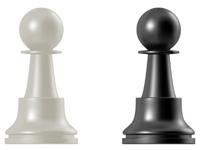 The Pawn is the most numerous piece in the game of chess, and in most circumstances, also the weakest. It historically represents infantry, or more particularly, armed peasants or pikemen. Each player begins a game with eight pawns, one on each square of the rank immediately in front of the other pieces. (The white pawns start on a2, b2, c2, d2, e2, f2, g2, h2; the black pawns start on a7, b7, c7, d7, e7, f7, g7, h7.)
The Pawn is the most numerous piece in the game of chess, and in most circumstances, also the weakest. It historically represents infantry, or more particularly, armed peasants or pikemen. Each player begins a game with eight pawns, one on each square of the rank immediately in front of the other pieces. (The white pawns start on a2, b2, c2, d2, e2, f2, g2, h2; the black pawns start on a7, b7, c7, d7, e7, f7, g7, h7.)
Individual pawns are referred to by the file on which they stand. For example, one speaks of "White's f-pawn" or "Black's b-pawn". Alternatively, they can be referred to by the piece which stood on that file at the beginning of the game, e.g. "White's king bishop's pawn" or "Black's queen knight's pawn". It is also common to refer to a rook's pawn, meaning any pawn on the a- or h-files, a knight's pawn (on the b- or g-files), a bishop's pawn (on the c- or f-files), a queen's pawn (on the d-file), a king's pawn (on the e-file), and a central pawn (on the d- or e-files).
Unlike the other pieces, pawns cannot move backwards. Normally a pawn moves by advancing a single square, but the first time a pawn moves, it has the option of advancing two squares. Pawns may not use the initial two-square advance to jump over an occupied square, or to capture. Any piece immediately in front of a pawn, friend or foe, blocks its advance. In the diagram, the pawn on c4 can move to c5; the pawn on e2 can move to either e3 or e4.
Unlike other pieces, the pawn does not capture in the same direction that it moves. A pawn captures diagonally forward one square to the left or right.
Another unusual rule is the en passant capture. It can occur after a pawn advances two squares using its initial two-step move option, and the square passed over is attacked by an enemy pawn. The enemy pawn is entitled to capture the moved pawn "in passing" – as if it had advanced only one square. The capturing pawn moves to the square over which the moved pawn passed (see diagram), and the moved pawn is removed from the board. The option to capture the moved pawn en passant must be exercised on the move immediately following the double-step pawn advance, or it is lost for the remainder of the game.
In general bishops are approximately equal in strength to knights, but depending on the game situation either may have a distinct advantage.
A pawn that advances all the way to the opposite side of the board (the opposing player's first rank) is promoted to another piece of that player's choice: a queen, rook, bishop, or knight of the same color. The pawn is immediately (before the opponent's next move) replaced by the new piece. Since it is uncommon for a piece other than a queen to be chosen, promotion is often called "queening". When some other piece is chosen it is known as underpromotion. The piece most often selected for underpromotion is a knight, used to execute a checkmate or a fork to gain a significant net increase in material. Underpromotion is also used in situations where promoting to a queen would give immediate stalemate. The choice of promotion is not limited to pieces that have been captured; thus a player could in theory have as many as ten knights, ten bishops, ten rooks or nine queens on the board simultaneously. While this extreme would almost never occur in practice, in game 11 of their 1927 world championship match, José Raúl Capablanca and Alexander Alekhine each had two queens in play from move 65 through move 66. While some finer sets do include an extra queen of each color, most standard chess sets do not come with additional pieces, so the physical piece used to replace a promoted pawn on the board is usually one that was previously captured. In informal games, when the correct piece is not available, a second queen is often indicated by inverting a previously captured rook, or placing two pawns on the same square. In tournament games however this is not acceptable, and may result in the arbiter ruling that the upturned piece is, in fact, a rook.[In the middlegame, a player with only one bishop should generally place friendly pawns on squares of the color that the bishop cannot move to. This allows the player to control squares of both colors, allows the bishop to move freely among the pawns, and helps fix enemy pawns on squares on which they can be attacked by the bishop. Such a bishop is often referred to as a "good" bishop.
Isolated pawn - Pawns on adjacent files can support each other in attack and defense. A pawn which has no friendly pawns in adjacent files is an isolated pawn. The square in front of an isolated pawn may become an enduring weakness. Any piece placed directly in front not only blocks the advance of that pawn, but cannot be driven away by other pawns.
In the diagram, Black has an isolated pawn on d5. If all the pieces except the kings and pawns were removed, the weakness of that pawn might prove fatal to Black in the endgame. In the middlegame, however, Black has slightly more freedom of movement than White, and may be able to trade off the isolated pawn before an endgame ensues.
Passed Pawn - A pawn which cannot be blocked or captured by enemy pawns in its advance to promotion is a passed pawn. In the diagram, White has a protected passed pawn on c5 and Black has an outside passed pawn on h5. Because endgames are often won by the player who can promote a pawn first, having a passed pawn in an endgame can be decisive – especially a protected passed pawn (a passed pawn that is protected by a pawn). In this vein, a pawn majority, a greater number of pawns belonging to one player on one side of the chessboard, is strategically important because it can often be converted into a passed pawn.
The diagrammed position might appear roughly equal, because each side has a king and three pawns, and the positions of the kings are about equal. In truth, White wins this endgame on the strength of the protected passed pawn, regardless which player moves first. The black king cannot be on both sides of the board at once – to defend the isolated h-pawn and to stop White's c-pawn from advancing to promotion. Thus White can capture the h-pawn and then win the game
Doubled Pawn - After a capture with a pawn, a player may end up with two pawns on the same file, called doubled pawns. Doubled pawns are substantially weaker than pawns which are side by side, because they cannot defend each other, they usually cannot both be defended by adjacent pawns, and the front pawn blocks the advance of the back one. In the diagram, Black is playing at a strategic disadvantage due to the doubled c-pawns.
There are situations where doubled pawns confer some advantage, typically when the guarding of consecutive squares in a file by the pawns prevents an invasion by the opponent's pieces.
Pawns which are both doubled and isolated are typically a tangible weakness. A single piece or pawn in front of doubled isolated pawns blocks both of them, and cannot be easily dislodged. It is rare for a player to have three pawns in a file, i.e. tripled pawns.
Wrong Rook Pawn - In chess endgames with a bishop, a rook pawn may be the wrong rook pawn, depending on the square-color of the bishop. This causes some positions to be draws that would otherwise be wins.
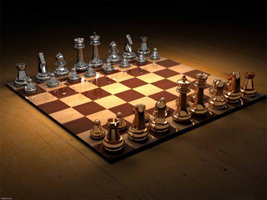
Copyright © 2025 by World Wide Web Foundry, LLC. -- All rights reserved